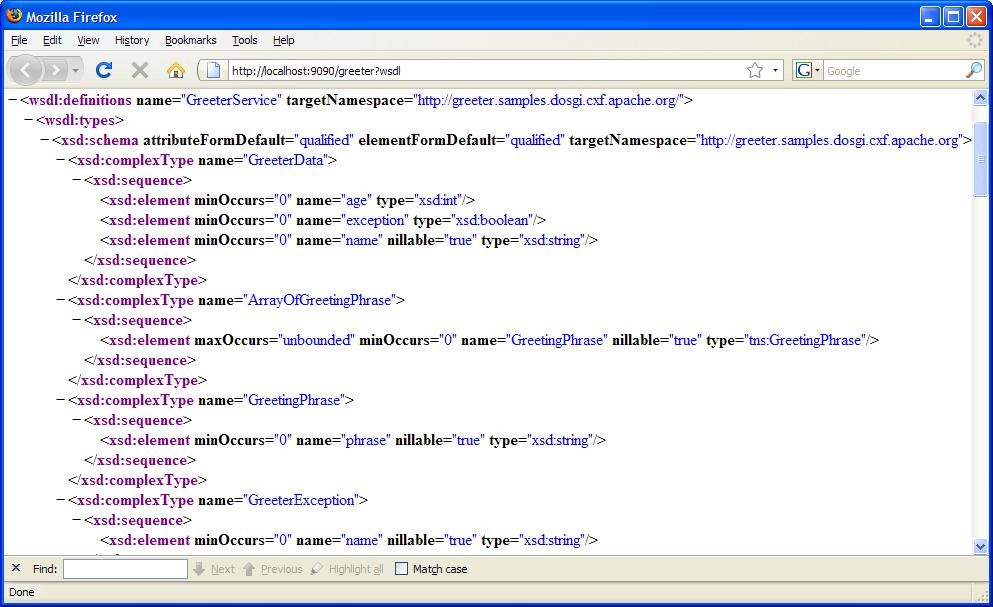|
This is a walkthrough of the Distributed OSGi Greeter Demo. It should help users of the Distributed OSGi get started with it. The greeter demo can be found in the samples/greeter directory of the SVN code base and implements a simple OSGi Greeter Service and a consumer to that service with a trivial UI. The Greeter demo designThe demo is composed of 3 bundles:
The Greeter Interface bundle exports the public interface GreeterService {
Map<GreetingPhrase, String> greetMe(String name);
GreetingPhrase [] greetMe(GreeterData name) throws GreeterException;
}
The In this walkthrough, the following setup will be used: The Server SideThe Greeter Service implementation bundle provides a trivial implementation of the GreeterService interface. Additionally, it has an Activator: public class Activator implements BundleActivator {
private ServiceRegistration registration;
public void start(BundleContext bc) throws Exception {
Dictionary props = new Hashtable();
props.put("service.exported.interfaces", "*");
props.put("service.exported.configs", "org.apache.cxf.ws");
props.put("org.apache.cxf.ws.address", "http://localhost:9090/greeter");
registration = bc.registerService(GreeterService.class.getName(), new GreeterServiceImpl(), props);
}
public void stop(BundleContext bc) throws Exception {
registration.unregister();
}
}
Besides creating the service instance, the activator sets the additional properties on the service that are required to make it available remotely:
Let's run the server in Felix 3.0.1. As a prerequisite it requires some of the OSGi Compendium Specification interfaces. These don't come with the Felix download, but you can install a bundle that contains these interfaces straight from Maven. To set up my Felix environment, I'm running the following commands: C:\felix-framework-3.0.1>
Welcome to Apache Felix Gogo
g! install http://repo1.maven.org/maven2/org/osgi/org.osgi.compendium/4.2.0/org.osgi.compendium-4.2.0.jar
g! start http://www.apache.org/dist/cxf/dosgi/1.2/cxf-dosgi-ri-singlebundle-distribution-1.2.jar
... some log messages may appear...
g! lb
0|Active | 0|org.apache.felix.framework (3.0.1)
1|Active | 1|org.apache.felix.bundlerepository (1.6.2)
2|Active | 1|org.apache.felix.gogo.command (0.6.0)
3|Active | 1|org.apache.felix.gogo.runtime (0.6.0)
4|Active | 1|org.apache.felix.gogo.shell (0.6.0)
5|Resolved | 1|osgi.cmpn (4.2.0.200908310645)
6|Active | 1|cxf-dosgi-ri-singlebundle-distribution (1.2.0)
Some log messages may come up now. Now let's start up the server-side greeter bundles. Like with the DOSGi bundle itself, I'm installing these straight from the Maven release repository.
g! start http://repo1.maven.org/maven2/org/apache/cxf/dosgi/samples/cxf-dosgi-ri-samples-greeter-interface/1.2/cxf-dosgi-ri-samples-greeter-interface-1.2.jar
g! start http://repo1.maven.org/maven2/org/apache/cxf/dosgi/samples/cxf-dosgi-ri-samples-greeter-impl/1.2/cxf-dosgi-ri-samples-greeter-impl-1.2.jar
... some log messages will appear ...
g! lb
START LEVEL 1
ID|State |Level|Name
0|Active | 0|System Bundle (3.0.1)
1|Active | 1|Apache Felix Bundle Repository (1.6.2)
2|Active | 1|Apache Felix Gogo Command (0.6.0)
3|Active | 1|Apache Felix Gogo Runtime (0.6.0)
4|Active | 1|Apache Felix Gogo Shell (0.6.0)
5|Resolved | 1|osgi.cmpn (4.2.0.200908310645)
6|Active | 1|Distributed OSGi Distribution Software Single-Bundle Distribution
7|Active | 1|CXF Distributed OSGi Greeter Demo Interface Bundle
8|Active | 1|CXF Distributed OSGi Greeter Demo Service Implementation Bundle
At the end of the log messages you will see one appear that says:
This WSDL was dynamically generated from the exposed The Service Consumer side.The Service Consumer Java code contains no specific Distribution-related elements. It's simply an Note that in many cases using an OSGi Component Framework such as Spring-DM, iPojo or OSGi DS is highly recommeded when writing OSGi Service Consumers. OSGi Services are highly dynamic in nature. They can come and go. Using a component framework will generally save you from writing So the remote service is simply looked up the normal way, via the OSGi Service Registry. <endpoint-descriptions xmlns="http://www.osgi.org/xmlns/rsa/v1.0.0">
<endpoint-description>
<property name="objectClass">
<array>
<value>org.apache.cxf.dosgi.samples.greeter.GreeterService</value>
</array>
</property>
<property name="endpoint.id">http://localhost:9090/greeter</property>
<property name="service.imported.configs">org.apache.cxf.ws</property>
</endpoint-description>
</endpoint-descriptions>
Let's run the consumer in Equinox, so that we have the bundles running in Equinox talking to a remoted service running in Felix! /eclipse> java -jar plugins/org.eclipse.osgi_3.6.0.v20100517.jar -console osgi> install install file:plugins/org.eclipse.osgi.services_3.2.100.v20100503.jar Bundle id is 1 osgi> install http://www.apache.org/dist/cxf/dosgi/1.2/cxf-dosgi-ri-singlebundle-distribution-1.2.jar Bundle id is 2 osgi> start 2 ... some log messages may appear... Some logging messages may appear. You can also automatically load the DOSGi bundles by appending the target/equinox.config.ini.append to you equinox config.ini file. osgi> install http://repo1.maven.org/maven2/org/apache/cxf/dosgi/samples/cxf-dosgi-ri-samples-greeter-interface/1.2/cxf-dosgi-ri-samples-greeter-interface-1.2.jar Bundle id is 3 osgi> install http://repo1.maven.org/maven2/org/apache/cxf/dosgi/samples/cxf-dosgi-ri-samples-greeter-client/1.2/cxf-dosgi-ri-samples-greeter-client-1.2.jar Bundle id is 4 osgi> ss Framework is launched. id State Bundle 0 ACTIVE org.eclipse.osgi_3.6.0.v20100517 1 RESOLVED org.eclipse.osgi.services_3.2.100.v20100503 2 ACTIVE cxf-dosgi-ri-singlebundle-distribution 3 INSTALLED cxf-dosgi-ri-samples-greeter-interface 4 INSTALLED cxf-dosgi-ri-samples-greeter-client osgi> start 4 After a few moments the following window appears:
The window appears once the ServiceTracker in the consumer has received a callback that the Map<GreetingPhrase, String> result = greeterService.greetMe("foobar");
I can see that the invocation has been received by the service implementation as in the Felix window the following appears. -> Invoking: greetMe(foobar) In the Equinox window I can see the response: osgi> greetMe("foobar") returns:
Hola foobar
Bonjour foobar
Hoi foobar
Hello foobar
|




